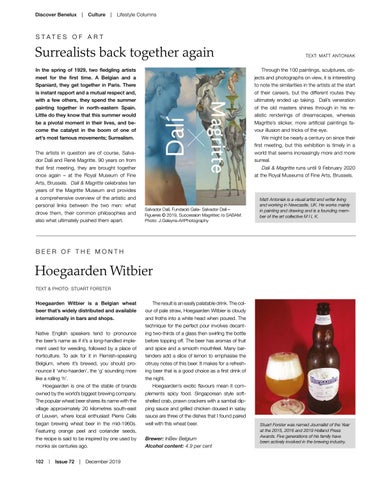Discover Benelux | Culture | Lifestyle Columns
STATES OF AR T
Surrealists back together again
Through the 100 paintings, sculptures, objects and photographs on view, it is interesting to note the similarities in the artists at the start of their careers, but the different routes they ultimately ended up taking. Dalí’s veneration of the old masters shines through in his realistic renderings of dreamscapes, whereas Magritte’s slicker, more artificial paintings favour illusion and tricks of the eye. We might be nearly a century on since their first meeting, but this exhibition is timely in a world that seems increasingly more and more surreal. Dalí & Magritte runs until 9 February 2020 at the Royal Museums of Fine Arts, Brussels.
In the spring of 1929, two fledgling artists meet for the first time. A Belgian and a Spaniard, they get together in Paris. There is instant rapport and a mutual respect and, with a few others, they spend the summer painting together in north-eastern Spain. Little do they know that this summer would be a pivotal moment in their lives, and become the catalyst in the boom of one of art’s most famous movements; Surrealism. The artists in question are of course, Salvador Dalí and René Magritte. 90 years on from that first meeting, they are brought together once again – at the Royal Museum of Fine Arts, Brussels. Dalí & Magritte celebrates ten years of the Magritte Museum and provides a comprehensive overview of the artistic and personal links between the two men: what drove them, their common philosophies and also what ultimately pushed them apart.
TEXT: MATT ANTONIAK
Salvador Dalí, Fundació Gala- Salvador Dalí – Figueres © 2019, Succession Magrittec /o SABAM. Photo: J.Geleyns-ArtPhotography
Matt Antoniak is a visual artist and writer living and working in Newcastle, UK. He works mainly in painting and drawing and is a founding member of the art collective M I L K.
BEER OF THE MONTH
Hoegaarden Witbier TEXT & PHOTO: STUART FORSTER
Hoegaarden Witbier is a Belgian wheat beer that’s widely distributed and available internationally in bars and shops. Native English speakers tend to pronounce the beer’s name as if it’s a long-handled implement used for weeding, followed by a place of horticulture. To ask for it in Flemish-speaking Belgium, where it’s brewed, you should pronounce it ‘who-haarden’, the ‘g’ sounding more like a rolling ‘h’. Hoegaarden is one of the stable of brands owned by the world’s biggest brewing company. The popular wheat beer shares its name with the village approximately 20 kilometres south-east of Leuven, where local enthusiast Pierre Celis began brewing wheat beer in the mid-1960s. Featuring orange peel and coriander seeds, the recipe is said to be inspired by one used by monks six centuries ago. 102 | Issue 72 | December 2019
The result is an easily palatable drink. The colour of pale straw, Hoegaarden Witbier is cloudy and froths into a white head when poured. The technique for the perfect pour involves decanting two-thirds of a glass then swirling the bottle before topping off. The beer has aromas of fruit and spice and a smooth mouthfeel. Many bartenders add a slice of lemon to emphasise the citrusy notes of this beer. It makes for a refreshing beer that is a good choice as a first drink of the night. Hoegaarden’s exotic flavours mean it complements spicy food. Singaporean style softshelled crab, prawn crackers with a sambal dipping sauce and grilled chicken doused in satay sauce are three of the dishes that I found paired well with this wheat beer. Brewer: InBev Belgium Alcohol content: 4.9 per cent
Stuart Forster was named Journalist of the Year at the 2015, 2016 and 2019 Holland Press Awards. Five generations of his family have been actively involved in the brewing industry.
